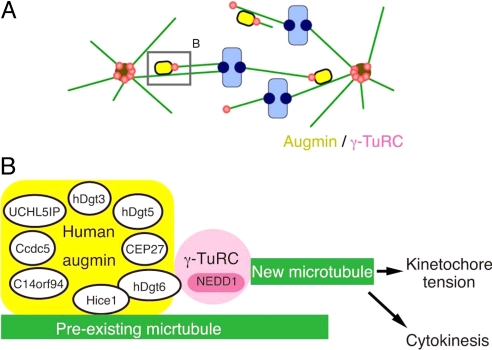Fig. 7.
Model for the augmin- and γ-TuRC-dependent MT amplification in the mitotic spindle in human cells. (A) The augmin/γ-TuRC machinery generates MTs within the spindle. The new MTs contribute to kinetochore MT formation and net kinetochore capture by the search-and-capture mechanism. This model was originally proposed in ref. 10. A similar mechanism may work within the central spindle during anaphase. (B) A speculative molecular model of the augmin/γ-TuRC-dependent MT generation. Human and Drosophila augmin were identified as 8-subunit complexes (human augmin subunits are described in this diagram). Hice1 is known to bind to MTs directly in vitro (14). Hice1-hDgt6 interaction was detected in the yeast 2-hybrid assay, whereas NEDD1-containing γ-TuRC was efficiently coprecipitated with the C-terminal fragment of hDgt6. Attenuation of this interaction caused defects in spindle MT generation. Thus, we suggest that augmin recruits γ-TuRC to spindle MTs, where γ-TuRC nucleates new MTs. This MT amplification process is critical for generating kinetochore tension and also completion of cytokinesis in human tissue culture cells.

